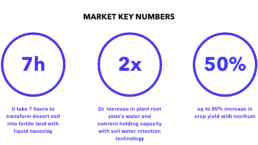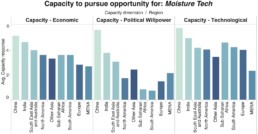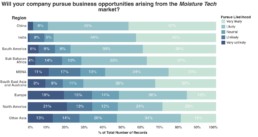With climate change drying out soils, new water-retaining solutions are emerging – opening up opportunities to make non-productive land arable. Traditionally, agriculture has been reliant on rainfall patterns or irrigation systems, but the products within the field of moisture tech have the potential to cut this dependency and ensure arable soils.
Climate change leads to an increase in the frequency and severity of droughts. It dries out our soils, and, with global food demand growing exponentially, it is critical that we find a way to combat this trend. Fortunately, new technologies are enabling soils to act as sponges and better retain water, making food production less dependent on rainfall and temperature and saving food producers money in the process.

Products and Services
The market for water-retaining soil solutions is an exciting and constantly developing. Part of the products are based on nanotechnology. In the case of water retention, nanoclay can turn dry sandy soils into fertile land. This product, when applied to soils, acts as a sponge that helps the soil retain water.
A new technology is also emerging called Subsurface Water Retention Technology (SWRT) with the ability to improve the water storage capacity of soils. It consists of membranes installed within the soil profile to prevent the loss of water via deep percolation. These water-saving membranes are a new innovation designed to retain water while permitting extended root growth beyond the depths of the membranes.
Another innovative product is the low-tech plant cocoon. This is a small shelter that houses and protects plants in their early stages of development. These shelters guard saplings from drying winds, allow for gradual release of water to the root system, and collect rainwater and dew to replenish reserves. Once the plant has reached maturity, the cocoon dissolves into organic substrate that helps the plant continue to flourish.
Soil moisture sensors are products enabling farmers to manage soil moisture in a smart way via constant access to data on the water content in the soils. Finally, an emerging element to this opportunity is the use of treated urban and industrial wastes to contribute to increased water retention in poor soils.
Market Size and Demand Drivers
Drought and desertification cause the loss of 12 million hectares of land each year – three times the size of Switzerland – on which 20 million tonnes of grain could have been grown. In China alone, more than 400 million residents are affected by desertification each year, causing a direct annual economic loss exceeding 10 billion USD.
The resulting potential market sizes of remedies against desertification are enormous. The potential to put drylands to productive use is a market driver in the face of increasing food demand. Forty percent of the Earth’s land surface is occupied by drylands – home to around 2 billion people.
The global soil moisture sensor market is expected to grow at a compound annual growth rate (CAGR) of 16.2 percent between 2015 and 2020 and reach 206.2 million USD by 2020.
Survey Findings
The market for applying technology to improve soils’ ability to retain water has been assessed very positively by respondents from China and North America. Leaders in these two regions are optimistic about the markets benefits for society and the capacity of the regions to pursue it.
According to the 2016 survey, it appears the market is most appealing to respondents under the age of 30 as well as to women.

In general, the surveyed leaders believe the political and economic capacities to further develop the market already exist. However, they perceive a lack of technological capacity to be a limiting factor in developing the market. This indicates further innovation in technology is needed to fully capitalize on this market.
In China, moisture tech is considered the opportunity business has the greatest capacity to pursue, of the 15 market surveyed in 2016. In Europe and Other Asia (Japan and Russia) the capacity is also perceived to be very high. Hence, we can expect the market to mature most rapidly in these three regions.
New technology to enhance soil fertility via water retention is positively welcomed in Sub Saharan Africa. Business leaders in this region are the ones who see the best business case in this market compared to leaders in the other regions.

The financial sector appears most likely to actively engage in this market. According to the 2016 survey, the financial sector is also the most optimistic about the positive impacts of this opportunity on society – making it a potential impact investment market.
Survey results from China and South America reveal a readiness by civil society, politicians, and business to actively work on driving the moisture tech market through advocacy.
This market was surveyed globally in 2016 by more than 5500 leaders from both the public and private sectors. The survey was conducted in collaboration with the research company YouGov. The survey results were originally published in the Global Opportunity Report 2017.

